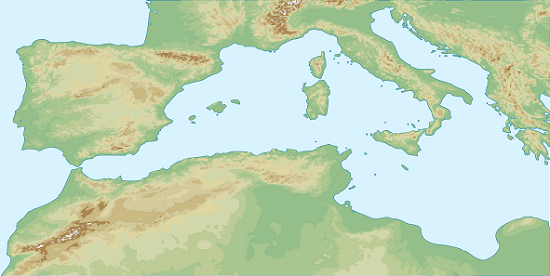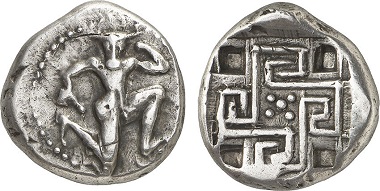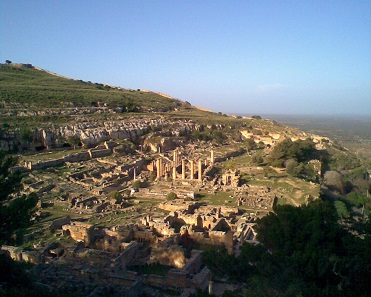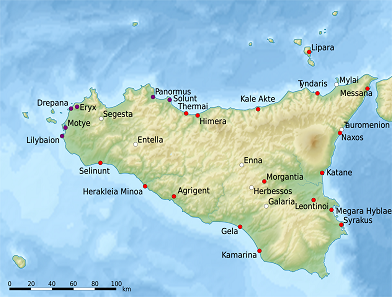translated by Annika Backe
On its narrowest points, Sicily is only 3 km away from Italy and 160 km away from Africa. Located right in the middle of the Mediterranean Sea, the island, thanks to this geographical position, became a hub for the people, a bridge connecting the East and the West, the North and the South. Phoenicians, Greeks, Romans, Vandals, Byzantines, Arabs, Normans, Aragonese and the Bourbons – many peoples have conquered the island and left their traces.
Europe’s history in microcosm
Despite belonging to Italy officially, Sicily still forms a separate country, by whose example we may experience the history of Europe in microcosm.
Sicily benefited from its central location in the Western part of the Mediterranean Sea as a springboard between Africa and Europe. Source: Pethrus / http://creativecommons.org/licenses/by-sa/3.0
As geology tells us, Sicily was always an island, not connected with Italy by a land bridge. Hence, the first settlers, who settled on the island around 20,000 BC, must have come by ship. At this point, we are not concerned with prehistoric times that did not know of any coins, though. We only want to emphasize that around 2000 BC, at the beginning of the Bronze Age, the Elymians settled in the North-West of Sicily, the Sicani in the West, and the Sicels in the East.
Daidalos was believed to be one of the builders of the famous labyrinth of Cnossos, in which the Minotaur lived. The two heroes can be seen on this coin from Gortyn. – Gortyn. Stater, about 425-360. From Gorny & Mosch Auction 224 (2014), 816.
Sicily: an island rich in tales
Numerous Greek tales revolve around the mythical prehistory of Trinacria, the island with the three capes. Legend has it that the gifted engineer Daidalos of Crete fled to Sicily using his home-made wings. With armed forces, King Minos tried to force him back to Crete again but he was killed by the host of Daidalos when taking a bath. Having lost their leader and being afraid of returning home without the king, the Cretans are said to have taken up residence on the island.
Many researchers have tried to take this tale as a reflection of an historical attempt of Cretan merchants to land on the island. An indication contrary to a Cretan settlement, however, is the lack of any Minoan finds in archaeological excavations. As a matter of fact, the Greeks of Archaic times are most likely the ones who have turned the Eastern part of Sicily into a purely Greek area of settlement as a result of several waves of colonization.
Settlement, not colonization
Colonization, and what we associate with it since the 19th-century colonial powers, is a misleading term when referring to what happened in the Greek civilization during the 8th century. An overpopulation and with it the need and discord in the cities of the Greek mother country forced young and adventurous men, who had lost their hope for a life worth living in their cramped and rigid native city, to embark on the open sea, searching for a future.
These impressive ruins have been preserved from the city of Cyrene in Libya. Photograph: Maher27777 / Wikicommons.
Emigration as a mitigation of social conflicts
An intriguing inscription that refers to the founding of the city of Cyrene in Libya helps us to imagine how this actually worked. Although the inscription dates from the first half of the 4th century, it contains several excerpts from old archival records. Instead of starting a civil war, two demographic groups in the city of Thera apparently reached an amicable agreement around the middle of the 7th century. It was decided that a fraction of the population was to leave the country. If the settlement abroad would not prove successful, the emigrants would be allowed to return home after five years and recover their former possessions with full rights. Every family was entitled to send one adventurous man to participate in the expedition. Of course, not all emigrations were conducted under the same conditions, but poverty, disunion in the mother city and the love of adventure, with different weightings, most likely played a part in several expeditions.
Important foundations in ancient Sicily. Source: Uwe Dede ring / https://creativecommons.org/licenses/by-sa/3.0/deed.de
Colonizing colonies
In the second half of the 8th century, therefore, Greeks settled at the East and the South coast of Sicily: Naxos, Leontinoi, Catane and Zankle Messana were founded by Chalcis on Euboia, Syracuse by Corinth, Megara Hyblaea by Megara, and Gela was a joint-foundation of Rhodes and Crete. The newly founded cities soon founded colonies themselves: Megara Hyblaea became the mother city of Selinus and Syracuse founded Camarina, while Gela, together with Rhodes as its mother city, founded Acragas.
Piety, not power
Being a mother city did not imply the right to interfere in the political and economic affairs of the daughter city. The relationship between the relatives was rather based on piety and a religious foundation. If the daughter city needed a certain authority to conduct a rite, an honorable citizen was sent to the mother city. On the other hand, the colonists were expected to send representatives to the great festivities in honor of the main deity of the mother city.
In the next episode we tell you more about the coins of some cities that were closely linked to each other because of their founding: Dankle-Messana and Rhegion or Himera, respectively, and Acragas.
The article was originally published in MünzenRevue 3/1997.
All parts of the series can be found in our archive.
If you are interested in Sicily, be sure not to miss the numismatic travel diary “Sicily in full bloom”! The whole series can also be found in our archive.









